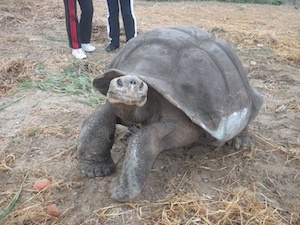Threats to the Galapagos Tortoise
 From the moment humans discovered them, the future of the giant tortoises of the Galapagos was in question. First the Spanish sailors caught them and ate them. Then successive waves of pirates used them as a source of food. A prison colony was set up on the islands and further stocks of tortoises were taken. Sailors made a point of capturing a number of tortoises to use as fresh meat when their initial supplies went bad. The tortoises could live for a long time without water, so they were kept alive on the ships and given water only a short time before they were due to be eaten. Whalers were the next in line, and they too killed large numbers. The tortoises were killed and used a source of oil.
From the moment humans discovered them, the future of the giant tortoises of the Galapagos was in question. First the Spanish sailors caught them and ate them. Then successive waves of pirates used them as a source of food. A prison colony was set up on the islands and further stocks of tortoises were taken. Sailors made a point of capturing a number of tortoises to use as fresh meat when their initial supplies went bad. The tortoises could live for a long time without water, so they were kept alive on the ships and given water only a short time before they were due to be eaten. Whalers were the next in line, and they too killed large numbers. The tortoises were killed and used a source of oil.
As all these different human invaders came and went, they left behind them a whole new set of animals that had been deliberately or accidentally introduced; dogs, cats, rats, pigs and goats etc. Many of the new inhabitants of the island affect the tortoise either by eating their eggs or destroying the vegetation eaten by the giant reptiles.
There were originally fifteen different subspecies of Galapagos giant tortoise each evolved to suit the conditions on the different islands. Five of the subspecies are now extinct. IUCN currently classifies the Galapagos Tortoise as Vulnerable.
The Galapagos giant tortoise is now strictly protected. Young tortoises are being raised in a programme by the Charles Darwin Research Station in order to help keep the remaining races from becoming extinct. Eggs are collected from places on the islands where they are threatened and when the young tortoises hatch they are kept in captivity until they are large enough to fend for themselves.
These captive breeding plans have been successful. There is still a problem, however, with the animals that have been introduced such as pigs, dogs and rats which dig up and eat the tortoise eggs and young hatchlings. Hopefully though with more research and careful protection the animal that gave its name to the islands will survive into the future.
Read More: Credits